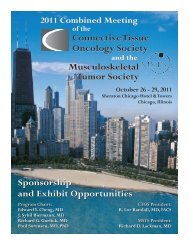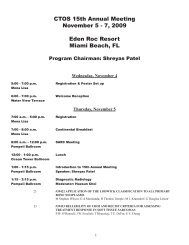207 Poster Session 2 - Connective Tissue Oncology Society
207 Poster Session 2 - Connective Tissue Oncology Society
207 Poster Session 2 - Connective Tissue Oncology Society
Create successful ePaper yourself
Turn your PDF publications into a flip-book with our unique Google optimized e-Paper software.
Scientific <strong>Poster</strong>s – <strong>Poster</strong> <strong>Session</strong> 2radiotherapy (RT) (pre or post) in 39% and chemotherapyin 15%. The vast majority received only RT mostly in theadjuvant setting. LF was the commonest reconstructiveprocedure (36%), followed by G (30%), PF (28%), FF (6%).All patients except one who underwent FF reconstructionhad R0 resection. Complications were observed in 19%.Three and five-year RFS was poorer in the G group (80%and 71%; p=0.42, Fig.1A) compared to LF (90% and 90%),PF (89% and 85%), FF (87% and 87%). A similar trend wasseen when only patients treated with RT or high-grade lesionswere analyzed (Fig.1B and 1C, respectively). In theRT subgroup, 3 and 5-year RFS were 69% and 51% in theG group compared to 75% and 75% in FF, 87% and 80% inPF, 81% and 81% in LF. Moreover, when only R1 resectionwhere considered, the outcome of patients in the G groupwas poorer (p=0.012, Fig. 2).Conclusion: This series showed that graft reconstructionsdespite being less difficult were associated to a high riskof local recurrence independently from the RT treatmentor grading.Fig. 1Fig. 2<strong>Poster</strong> #180UNDIFFERENTIATED SOFT TISSUE SARCOMA INCHILDREN AND YOUNG ADULTS: THE MDANDERSON CANCER CENTER EXPERIENCEWinston W. Huh, MD 1 ; Wei-Lien Wang 2 ; Alexander J. Lazar 2 ;Najat C. Daw 1 ; Cynthia E. Herzog 1 ; Dennis P. Hughes 1 ;Peter M. Anderson 1 ; Mark F. Munsel 3 ; Mary FrancesMcAleer 4 ; Andrea Hayes-Jordan 51Pediatrics, University of Texas MD Anderson Cancer Center,Houston, TX, USA; 2 Pathology, University of Texas MDAnderson Cancer Center, Houston, TX, USA; 3 Biostatistics,University of Texas MD Anderson Cancer Center, Houston,TX, USA; 4 Radiation <strong>Oncology</strong>, University of TexasMD Anderson Cancer Center, Houston, TX, USA;5Surgical <strong>Oncology</strong>, University of Texas MD AndersonCancer Center, Houston, TX, USAObjective: Undifferentiated sarcomas (UDS) are uncommonpediatric soft tissue tumors with characteristics indicatingmesenchymal origin, but do not have characteristicsfor differentiation to known sarcoma subtypes. Little dataare published regarding the clinical and histologic characteristicsof these tumors. We present our institutionalexperience with pediatric and young adult UDS patients.Methods: Retrospective review of medical records of patients< 22 years of age at diagnosis and treated for UDSat the University of Texas MD Anderson Cancer Centerfrom 1995 to 2008. Tumor histology was reviewed andconfirmed to be UDS.Results: There were 17 patients analyzed; 10 patients (59%)were male. Median age at diagnosis was 14.2 years (range6.2 – 21.1 years). Extremity was most common primary site(n=7; 41%) followed by head/neck (n=6; 35%). The majorityof tumors were T1 in size (n=11; 65%) and intermediatehistologic grade (n=9; 53%). Tumor morphologic characteristicsincluded: spindle cells in 5 tumors; round cells(n=4); mix of spindle cells with either pleomorphic (n=3),epithelioid (n=2), or myxoid cells (n=1). Only 1 tumorwas desmin positive (1/14; 7%) and 3 were S100 positive(3/14; 21%). Five tumors (5/6) were CD 99 positive. UsingIntergroup Rhabdomyosarcoma Study Group (IRSG)group classification, 5 tumors were Group I; 5 Group II; 6Group III; and 1 Group IV. Treatment comprised of: surgeryonly in 2 patients; surgery + chemotherapy in 5; surgery+ radiation therapy in 5; surgery + RT + chemotherapy in5. Median dose of RT was 53 Gray (Gy; range 38 – 60 Gy);most cases received adjuvant RT (n=8). Five of 17 tumors(29%) were completely resected, 5 had positive microscopicmargins, and 6 (35%) were biopsied only.Median duration of follow up was 80 months (range 7 – 156months). The 5-year recurrence-free survival (RFS) estimatewas 64% (95% CI 44% - 92%) and overall survival (OS)was 88% (95% CI 74% - 100%). Six patients experiencedrelapse or disease progression with distant metastasis beingmost common presentation of failure (n=5); 2 patientsdied of disease. Most common characteristics for patientswith relapse were positive surgical margin (n=4) and hightumor grade (n=4).Conclusion: Overall survival in this small UDS cohort wasbetter than prior published IRSG studies. Risk factors fortreatment failure were similar to other studies. Additionalstudy in a larger cohort is needed to determine commonhistologic characteristics.262






